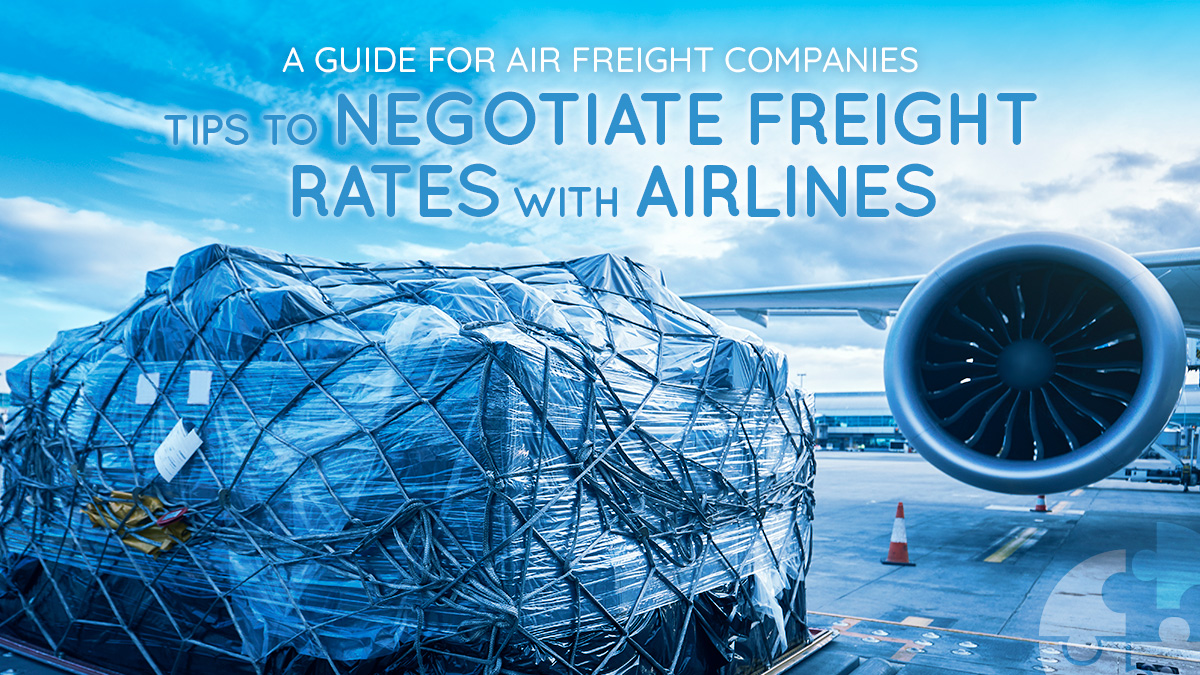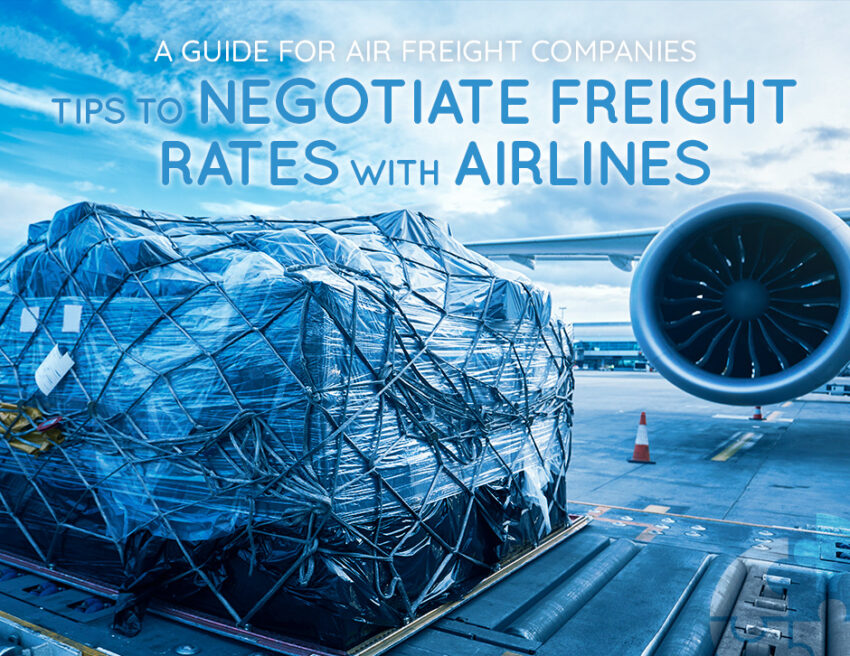Negotiating freight rates with airlines is a critical aspect for air freight companies aiming to remain competitive and maintain healthy profit margins. Whether you are handling time-sensitive cargo, perishable goods, or oversized shipments, knowing how to effectively negotiate air freight rates can make all the difference. Below are several tips and strategies that can help air freight companies secure the best possible rates with airlines.

Understand the Market Conditions for Air Freight Companies
Conduct Thorough Market Research
Before initiating negotiations, it’s essential to understand the current market landscape. Factors like fuel prices, seasonal demand, geopolitical events, and global economic trends can all affect air freight rates. For example, peak shipping seasons like the holidays or high-demand periods often lead to a spike in rates, while off-peak periods may provide opportunities for lower rates.
Staying informed about industry trends through market analysis will help air freight companies set realistic expectations and ensure they’re negotiating from a position of knowledge. Additionally, it’s important to research the specific routes you frequently use, as rates can vary based on geographic location, flight frequency, and available cargo space.
Know Your Competition
Airlines are likely negotiating with multiple air freight companies, so understanding what your competitors are offering is important. By benchmarking against competitors, you can identify where you stand in terms of pricing, service offerings, and customer satisfaction. This can give you valuable insights into your negotiation strategy and help you highlight the unique value your company brings to the table.
Preparing for Negotiations with Airlines
Gather Historical Data
Preparation is key to any successful negotiation. Collect data from your past shipping operations, including shipment volume, weight, dimensions, and frequency of shipments. By presenting airlines with a detailed history of your shipping needs, you’ll demonstrate that you’re a well-organized and serious partner. Airlines are more likely to offer favorable rates if they see that you’re consistent and have a predictable volume of cargo.
Define Your Objectives
Before entering negotiations, clearly define what you aim to achieve. Are you looking for lower rates, better service terms, or additional perks such as priority loading? Defining your objectives will help you stay focused during negotiations and measure your success afterward. Knowing your bottom line and having a range of acceptable outcomes will also allow you to navigate the negotiation process with confidence.
Building Strong Relationships with Airlines
Focus on Long-term Partnerships
For air freight companies, building long-term partnerships with airlines can lead to more favorable rates and terms. Airlines value loyalty and consistency, so if they know you will provide them with regular business, they may offer discounts or other perks. Ensure that your communication is transparent and that both parties understand each other’s needs. Long-term relationships based on trust can help you secure better deals over time and provide a competitive edge.
Highlight Your Value as a Partner
In negotiations, emphasize the value your company brings to the airline. Whether it’s a steady stream of business, timely payments, or specialized expertise in handling specific types of cargo, make it clear why your partnership is mutually beneficial. Airlines are more inclined to offer competitive rates to air freight companies that are seen as reliable and valuable partners.
Key Negotiation Strategies for Air Freight Companies
Leverage Shipment Volume for Discounts
If your company handles a high volume of shipments, use this as leverage during negotiations. Airlines often offer volume discounts for companies that can guarantee a certain amount of cargo over a specified period. Outline your projected shipment volume to airlines and propose bulk deals that benefit both parties. Even if your volume varies, you can negotiate a flexible arrangement that offers discounted rates when your volume meets certain thresholds.
Bundle Routes and Services
Air freight companies often handle multiple shipping routes or provide a range of services such as warehousing or ground transport. Consider bundling several services or routes in your negotiations to create a more appealing package for the airline. By offering a more significant portion of your logistics operations, you increase your bargaining power and can negotiate more favorable terms across the board.
Explore Multiple Airline Options
One of the most effective ways to strengthen your negotiating position is to explore rates from multiple airlines. Use the offers from different airlines as leverage to get better rates. Informing one airline that you have received a more competitive offer from another can prompt them to adjust their rates or offer better terms to secure your business. This tactic ensures that you are not reliant on a single carrier and helps you avoid overpaying for air freight services.
Overcoming Common Challenges in Rate Negotiations
Address Rate Fluctuations Proactively
Freight rates, particularly in air transport, can fluctuate rapidly due to factors like fuel surcharges and changes in demand. To protect your company from sudden cost increases, negotiate for rate stability or cap clauses that limit how much rates can rise over a specified period. Some airlines may also offer fixed-rate contracts that provide cost predictability for air freight companies. While these contracts might require a commitment, they can offer security in an otherwise volatile market.
Balance Price and Service Quality
Negotiating for the lowest rate isn’t always the best strategy. Air freight companies must balance price with service quality, transit times, and additional services like tracking or expedited handling. Make sure to clarify your non-negotiables, such as delivery windows, shipment handling, or insurance requirements, while negotiating rates. Sometimes paying a slightly higher rate for premium services can lead to greater overall value for your company and clients.
Utilizing Technology for Better Negotiations
Use Freight Rate Management Tools
Air freight companies can leverage technology, such as freight rate management platforms, to simplify and streamline the negotiation process. These tools allow you to compare rates from multiple airlines, track historical pricing trends, and analyze route data more efficiently. With access to this information, you can make data-driven decisions and negotiate from a position of strength.
Digital Communication Platforms
To facilitate smoother negotiations, many airlines and air freight companies are using digital communication platforms that offer real-time updates and easy access to documentation. These tools not only enhance communication but also help maintain transparency throughout the negotiation process, ensuring that both parties are on the same page regarding terms and conditions.
Conclusion
For air freight companies, negotiating favorable freight rates with airlines is crucial for maintaining profitability and offering competitive pricing to clients. By understanding the market, preparing thoroughly, building strong relationships, and employing strategic negotiation tactics, air freight companies can secure better rates and improve their overall operations. Utilizing technology and staying flexible during negotiations will also help air freight companies remain competitive in a rapidly changing industry.


